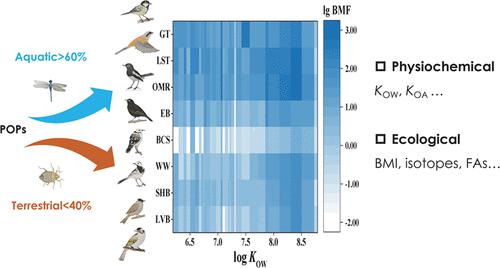当前位置:
X-MOL 学术
›
Environ. Sci. Technol.
›
论文详情
Our official English website, www.x-mol.net, welcomes your feedback! (Note: you will need to create a separate account there.)
Biomagnification of Persistent Organic Pollutants from Terrestrial and Aquatic Invertebrates to Songbirds: Associations with Physiochemical and Ecological Indicators
Environmental Science & Technology ( IF 11.4 ) Pub Date : 2022-08-11 , DOI: 10.1021/acs.est.2c02177 Xiaodan Wu 1 , Xiaobo Zheng 1, 2 , Lehuan Yu 3 , Ruifeng Lu 4 , Qiang Zhang 5 , Xiao-Jun Luo 4, 6 , Bi-Xian Mai 4, 6
Environmental Science & Technology ( IF 11.4 ) Pub Date : 2022-08-11 , DOI: 10.1021/acs.est.2c02177 Xiaodan Wu 1 , Xiaobo Zheng 1, 2 , Lehuan Yu 3 , Ruifeng Lu 4 , Qiang Zhang 5 , Xiao-Jun Luo 4, 6 , Bi-Xian Mai 4, 6
Affiliation

|
Biomagnification of persistent organic pollutants (POPs) is affected by physiochemical properties of POPs and ecological factors of wildlife. In this study, influences on species-specific biomagnification of POPs from aquatic and terrestrial invertebrates to eight songbird species were investigated. The median concentrations of polychlorinated biphenyls (PCBs) and polybrominated diphenyl ethers (PBDEs) in birds were 175 to 13 200 ng/g lipid weight (lw) and 62.7 to 3710 ng/g lw, respectively. Diet compositions of different invertebrate taxa for songbird species were quantified by quantitative fatty acid signature analysis. Aquatic insects had more contributions of more hydrophobic POPs, while terrestrial invertebrates had more contributions of less hydrophobic PCBs in songbirds. Biomagnification factors (BMFs) and trophic magnification factors had parabolic relationships with log KOW and log KOA. The partition ratios of POPs between bird muscle and air were significantly and positively correlated with log KOA of POPs, indicating respiratory elimination as an important determinant in biomagnification of POPs in songbirds. In this study, the species-specific biomagnification of POPs in songbird species cannot be explained by stable isotopes of carbon and nitrogen and body parameters of bird species. BMFs of most studied POPs were significantly correlated with proportions of polyunsaturated fatty acids in different species of songbirds.
中文翻译:

从陆地和水生无脊椎动物到鸣禽的持久性有机污染物的生物放大:与物理化学和生态指标的关联
持久性有机污染物 (POPs) 的生物放大率受 POPs 的理化性质和野生动物生态因素的影响。在这项研究中,调查了 POPs 从水生和陆生无脊椎动物到八种鸣禽物种对物种特异性生物放大的影响。鸟类中多氯联苯 (PCB) 和多溴联苯醚 (PBDE) 的中位浓度分别为 175 至 13 200 ng/g 脂重 (lw) 和 62.7 至 3710 ng/g lw。通过定量脂肪酸特征分析对鸣禽物种的不同无脊椎动物类群的饮食组成进行量化。水生昆虫对更疏水的持久性有机污染物的贡献更大,而陆生无脊椎动物对鸣禽的疏水性更低的多氯联苯贡献更大。 K OW并记录 K OA。POPs在鸟类肌肉和空气中的分配比与POPs的log K OA呈显着正相关,表明呼吸消除是鸣禽POPs生物放大的重要决定因素。在这项研究中,鸣禽物种中持久性有机污染物的物种特异性生物放大不能用碳和氮的稳定同位素以及鸟类的身体参数来解释。大多数研究的持久性有机污染物的 BMF 与不同种类鸣禽中多不饱和脂肪酸的比例显着相关。
更新日期:2022-08-11
中文翻译:

从陆地和水生无脊椎动物到鸣禽的持久性有机污染物的生物放大:与物理化学和生态指标的关联
持久性有机污染物 (POPs) 的生物放大率受 POPs 的理化性质和野生动物生态因素的影响。在这项研究中,调查了 POPs 从水生和陆生无脊椎动物到八种鸣禽物种对物种特异性生物放大的影响。鸟类中多氯联苯 (PCB) 和多溴联苯醚 (PBDE) 的中位浓度分别为 175 至 13 200 ng/g 脂重 (lw) 和 62.7 至 3710 ng/g lw。通过定量脂肪酸特征分析对鸣禽物种的不同无脊椎动物类群的饮食组成进行量化。水生昆虫对更疏水的持久性有机污染物的贡献更大,而陆生无脊椎动物对鸣禽的疏水性更低的多氯联苯贡献更大。 K OW并记录 K OA。POPs在鸟类肌肉和空气中的分配比与POPs的log K OA呈显着正相关,表明呼吸消除是鸣禽POPs生物放大的重要决定因素。在这项研究中,鸣禽物种中持久性有机污染物的物种特异性生物放大不能用碳和氮的稳定同位素以及鸟类的身体参数来解释。大多数研究的持久性有机污染物的 BMF 与不同种类鸣禽中多不饱和脂肪酸的比例显着相关。



























 京公网安备 11010802027423号
京公网安备 11010802027423号